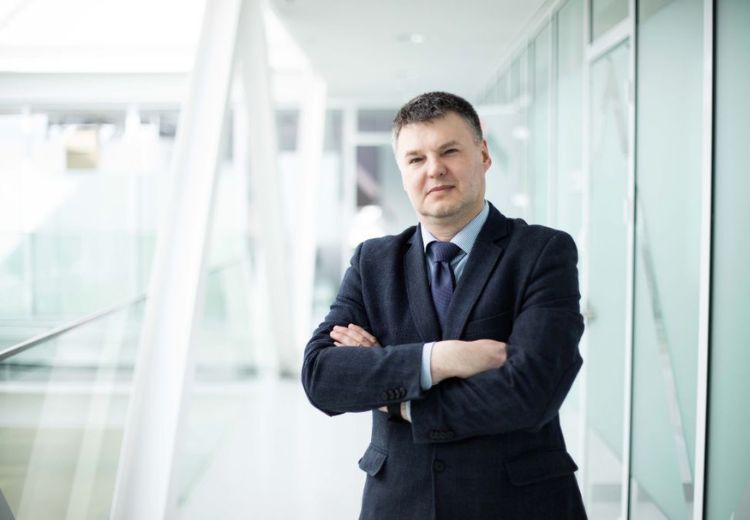Invention by Lithuanian researchers: new technology for monitoring atrial fibrillation

Sponsored by

Researchers from two Lithuanian universities have developed a patient-safe monitoring technology to identify and manage individual factors provoking atrial fibrillation.
The technology is a result of the successful collaboration of Kaunas University of Technology Biomedical Engineering Institute (KTU BMEI) and Vilnius University (VU) Santaros Clinics.
Atrial fibrillation is the most common heart rhythm disorder (arrhythmia), diagnosed in 33 million people worldwide. Due to a rapidly ageing population, it is estimated that the prevalence of this condition will increase two-fold in the coming decades.
It is therefore important to diagnose and treat atrial fibrillation in time, as it can eventually lead to serious complications such as stroke. The disease usually starts with self-terminating so-called “paroxysmal episodes”, which, if recognised in time, can be treated by non-medication means.
Smart bracelet for heart rhythm monitoring already developed
These episodes may be different for each patient: for some, they may last for a short period and recur infrequently, for others, the episodes can be longer and more frequent. Untreated atrial fibrillation eventually develops into a persistent condition, which is more complicated to treat.
For more than 10 years, the researchers at KTU BMEI have been working in the field of atrial fibrillation monitoring technology development, and the result of their efforts are globally new technological solutions.
“We are focusing on developing technologies, which are needed for the public and contemporary medicine. For example, due to the prevalence of this condition, every person older than 65 should be checked for atrial fibrillation. Non-invasive, compact wearable devices are an attractive solution for monitoring the health status of such high-risk groups,” says Vaidotas Marozas, the Director of KTU Biomedical Engineering Institute (BEI).
Several years ago, KTU researchers developed a smart bracelet with an algorithm that can identify atrial fibrillation. This bracelet has been used together with other devices in the TriggersAF project funded by the EU Structural Funds.

A link between atrial fibrillation and insomnia observed
The project aims to develop and test methods that allow patients to identify their individual arrhythmia triggers. From the scientific literature it is known that for some patients, atrial fibrillation episodes can be provoked by certain modifiable factors such as alcohol, increased physical activity, stress, and sleep disturbances. Identifying and avoiding individual factors would help determine nonpharmaceutical intervention methods for arrhythmia management.
As the project addresses a clinical problem, it is important to have onboard clinicians with clinical experience who deal with atrial fibrillation every day. One of them is Justinas Bacevičius, a cardiologist at VU Santaros Clinic.
“Although we see a wide variety of atrial fibrillation patients in our hospital, two types can be distinguished. The first group include older, overweight, diabetic, hypertensive patients or those having sleep apnoea. The second group are the complete opposite – often they are young, professional sportspersons, businesspeople or performers who are experiencing a lot of stress,” says Bacevičius.
He says that the data from the patients suggests a link between the onset of arrhythmia and sleep disorders. Interestingly, even in patients who are not diagnosed with sleep apnoea, a correlation between snoring during sleep and the onset of atrial fibrillation in the morning or later in the day has been identified.
A unique databased developed
There were no objective methods to identify the individual factors influencing arrhythmia in patients. KTU BMEI researchers in collaboration with cardiologists from VU Santara Clinic and their long-term partner Leif Sörnmo from Lund University in Sweden have proposed one. It assumes that arrhythmia parameters, such as the relative duration of an episode, increase after an arrhythmia-provoking factor.
“The essence of our proposed approach is that the patient uses a wearable bio signal-recording device for a set monitoring period, e.g. two weeks, and enters potential triggers for atrial fibrillation into a mobile app. For the next two weeks, the patient avoids the identified potential triggers and the relation is assessed by an equation proposed by KTU BMEI researcher Dr Andrius Petrėnas. If a correlation between the influencing factor and the occurrence of arrhythmia is detected, the patient is advised to avoid the specific identified factor,” explains Vilma Pluščiauskaitė, a PhD student at KTU and a junior researcher of the project.
The project’s database is the first of its kind in the world: it includes the recorded patients’ physiological signals, such as electrocardiogram and photoplethysmogram, and potential arrhythmia-provoking factors entered in a patient’s mobile app. The database collected by the researchers allowed them to test the developed method and identify arrhythmia-provoking factors in individual patients.
The project leader, Prof Marozas, is delighted with the success of the project, which will allow further development of the technology.
“The database generated by the project is a unique result. We have managed to interest an international consortium funded by the European Metrology Association in this data. This consortium has invited us to join their new project as a partner and we will continue our work,” says Marozas, the Head of KTU Biomedical Engineering Institute.
Patient-friendly solutions are key
The lack of technology to individually identify arrhythmia-provoking factors is probably also due to the fact that the monitoring of potential factors has been inconvenient for the patient, for example, the patient is burdened with various sensors and other methods of observation. Or, they may be asked to fill in numerous questionnaires to identify the factors, which are inherently subject to recall bias, where the patient simply forgets about a potential arrhythmia-provoking factor or is reluctant to acknowledge the presence of certain factors, e.g. alcohol consumption.
“Certain influencing factors for arrhythmia, such as increased exercise, stress or sleep disturbances, can be identified from physiological signals by the dedicated algorithms. However, other influencing factors, such as alcohol consumption, are difficult to identify in the signals, so it is best if the patient has the opportunity to indicate when he or she consumed alcohol,” says Pluščiauskaitė.
The proposed technology does not force the patient to wear uncomfortable sensors – a smart bracelet, which has already become an essential accessory for many, is enough. The potential arrhythmia triggers are entered by the patient on the mobile app, in the provided smartphone.
It is hoped that in the future, identifying these arrhythmia triggers will only require a smart bracelet incorporating complementary sensors and a signal-processing algorithm.
Find out more about biomedical engineering research at Kaunas University of Technology, Lithuania.